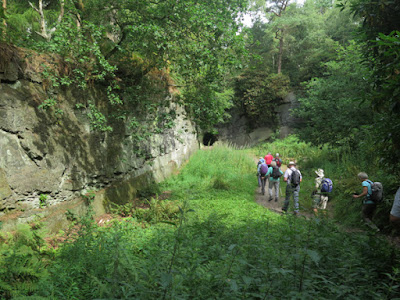 |
| Examining the quarry face in Church Quarry |
In a year that has yet again been very barren for my professional work and spent near to home, I kept myself occupied for much of the time by focussing on the organisation of the Heritage Open Days for St. Helen’s church in Treeton.
I still made time for the occasional trip out to take advantage of the wonderful summer weather, however, with trips to Pontefract Castle and Saltaire by myself and on trips with the Sheffield U3A Geology Group. When the latter announced that the itinerary for 2018 included a trip to Alderley Edge, I put it in my diary straight away.
Alderley Edge forms an uplifted area comprising Triassic conglomerates and sandstones, with subsidiary marl, which is surrounded by lower lying land that is covered in Quaternary till. I had seen examples of similar l during my previous U3A trip to the Churnet Valley, but the area around here has had a long history of mining, with both copper and cobalt being principally exploited since ancient times.
Our leader on the day was Chris Darmon, a very experienced geologist and field trip leader, and after we had all arrived at the Wizard Tearoom, we set off to Church Quarry, where we stayed all morning to closely examine the Helsby Sandstone Formation, which contains various separate members.
This medium sized quarry was worked in the 19th century for building stone and exhibits dipping strata, with the lowest metre or so of the principal quarry face consisting of a uniform medium grained sandstone separated from the conglomerate above it by a distinct unconformity.
The conglomerate in particular provided the group with the opportunity to observe cross bedding, scour structures, variations in grain size and other features, which indicate that the sediment had been formed in a river channel, whose extent and direction could be worked out approximately from field evidence.
As with other Triassic sandstones that I had seen in the Churnet Valley, Alton Towers, Nottingham and around Doncaster, the distinctly rounded pebbles found in the conglomerate are mainly quartz. It is thought that these are Devonian in age and have been reworked from rocks of this age that were found in the area that is now Budleigh Salterton in Devon and brought by a north flowing river into the area now occupied by the Cheshire basin, as a flash flood.
In one corner of the quarry, a short man made tunnel provides evidence of the mining activities in the area. The appearance of cobalt mineralisation of the sandstone here was investigated for its economic potential, but further investigation soon discovered that it was worthless and the tunneling ceased.
 |
| A view along the aborted tunnel |







No comments:
Post a Comment